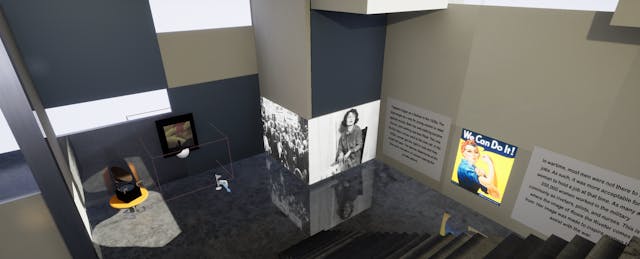Most educators are looking to create opportunities for all students to have deeper and more meaningful learning experiences, while also adding skill acquisition and student agency. Interactive learning environments are making it possible to achieve all of this more than ever now. Real-time technology like Epic Games' Unreal Engine has emerged as a successful tool and resource to implement this type of teaching and learning. We spoke with ninth-grade History Teacher Nick Pant, from Dayton Regional STEM School, about successfully implementing Unreal Engine in the classroom.
EdSurge: Technology is an integral part of all learning experiences now. What are you seeing that is engaging students in the gaming and interactive space?
Pant: The best learning happens when students are able to use technology as a method to enhance what they are already doing. Students at Dayton are focused on large interdisciplinary projects and problem-solving. They are excited to apply their skills in new ways, and technology enables them to solve problems with strategies they might not have realized before.
Specific to the interactive 3D environments, students are engaged when they are able to apply their own creativity. As an example, they are using Unreal Engine to design their Virtual History Museum Projects. Their favorite aspect is the ability to make the museum that they’ve always wanted to visit. Many students think history is boring, but they enjoy video games, animation and computers. Instead of putting history content into a static space, they can make their museum float on water or reside inside a volcano. The history standards are still present in their museum, but so is their idea of what makes history engaging.

How would you explain the value of this technology in terms of implementing creative opportunities and storytelling skills for students?
Storytelling is a major component of so many professions. Obviously, it’s used in video games and other media such as movies. This ability to describe events in a creative, efficient way along a linear narrative is used in many aspects of life. I don’t think it’s a stretch to encourage using interactive 3D to tell stories, because being able to explain a process or task is so similar to telling a story. When my game design students are tasked with creating a tutorial, they are expected to place themselves in the shoes of their audience. Going from point A to point B is the same process whether it’s technical writing or fiction. Although my students work toward creating a museum in Unreal Engine, their final product is actually a screen recording of themselves exploring their virtual world. They talk about the content that is displayed, about any struggles they overcame and about anything interesting they found working in Unreal Engine. This is an invaluable skill that prepares them for professional applications in the workforce.
What professional skills do you wish you learned in school to better prepare yourself for your career? How is this preparation evolving for your students?
I am by no means a game designer. I am a social studies teacher who got introduced to game design as a result of trying to motivate students to study history and then be excited to share their learning. Coding is difficult to me, but it comes much more naturally to my students as they start coding in sixth grade. There, they start their digital portfolios that will be with them through graduation. I’m sure I’d be able to find more connections to the technology if I learned coding as early and successfully as they have. It’s clear to me that the coding background enables students to more naturally see the “behind the scenes” of game design. This allows them to problem-solve more efficiently, because they understand how the technology is used, even if they don’t understand specifics. You can learn more about how we use digital portfolios and our critique process by viewing a StoryMap I made using Geographic Information Systems (GIS).
How can these experiences help students prepare for diverse careers in many different industries that require foundational management, production and implementation skills?
Skills such as critical thinking, collaboration, persistence, inquiry and leadership are more relevant than ever, especially in project work. Even though advanced technology is used, students understand that it’s the ability to be organized and communicate that leads to results. So, when a student wants to learn how to manipulate landscapes, which isn’t directly taught as part of the project, they can look to the internet for guidance. I could tell them how to use the landscape tool, but I think they get more out of the experience by learning how to search to find the solution on their own. Learning how to search for answers online is a skill that will serve them well in all avenues. They also learn time management, organization, communication and the ability to prioritize tasks.
What was the "aha" moment that convinced you that using Unreal Engine was the right choice? Any particular stories that stick out?
I always implement critique session days into the project, and this year, I’ve been modifying them for virtual learning. I used them with my Game Design II and III students, who created Unreal Engine tutorials to help the freshmen meet their goals for the museum project. I always enjoy the students taking the critique sessions so seriously, especially with this project because it’s meant to be a game that is played by an audience. It’s been difficult to do that this year, which led me to believe the feedback would diminish. However, I was pleasantly surprised when the feedback was so kind, helpful and specific. I’m confident the Virtual History Museums will benefit as a result of the support from the upperclassmen. These “aha” moments come time and time again when students find value in overcoming struggles. Seeing them use their inquiry and persistence skills at such professional levels is inspiring.

Is your success repeatable? What do teachers who want to use Unreal Engine need to have before they get started in their classrooms?
Unreal Engine is free to install. Epic Games, the creator of Unreal Engine, offers a wide variety of tutorials, workshops and support for anyone interested in incorporating the technology into their classrooms. I suggest taking a few days to work through the introductory tutorials to see how easy using Unreal Engine can be. It can quickly become complex, but it doesn’t need to be the teacher’s role to become an expert. In my experience, students embrace the challenge to figure things out because they understand that, just as in the real world, the reward for troubleshooting is that their vision becomes reality. In order to be unique, students know they must be creative in their problem-solving.
Don’t be afraid to fail. Just as with students, it is through the struggle that lasting learning occurs. There is a reason that people continue to play video games even after seeing that “game over” screen. After two weeks of learning Unreal Engine, many students are better at it than I am. And I’ve been using it for over six years. Instead of being scared or embarrassed that students may know more than you, be excited at the possibilities of students exceeding their goals, increasing their confidence and being proud of their work.

As a social studies teacher, what would you say to others in your discipline—as well as math, science and English—about the value of technology like Unreal Engine for your students?
Once students learn the basics, they are able to incorporate Unreal Engine in a variety of ways. This includes math students creating Ferris wheels, American Government students debating the best amendment to the Constitution or students using Unreal Engine as a presentation tool instead of PowerPoint. They can turn their presentations into interactive experiences for the audience by allowing them to play their games while learning the content. This gives the audience a way to be more engaged with the topic.
As part of STEMmersion—a two-week immersive experience where students take the same atypical class all day long to end the school year—students made connections between Star Wars and Unreal Engine. They created tutorials to design something from the Star Wars universe while making connections to physics and technology. Another STEMmersion had students incorporating architecture into Unreal Engine, where they learned basic architectural skills from experts and then modeled their school in Unreal Engine. The possibilities are endless across subject areas, grade levels and projects.
Get started with free resources
To learn how to leverage these tools in your classroom, check out the free lesson plans that other educators have been kind enough to share.
There are also over 100 hours of free online courses available on Unreal Online Learning, including Your First Hour with Unreal Engine.
You can also download your free copy of the Creator’s Field Guide to Emerging Careers in Interactive 3D to help prepare your students for the jobs of tomorrow.


